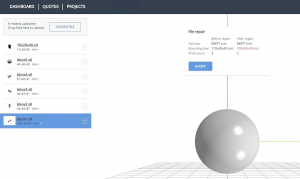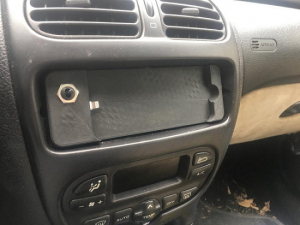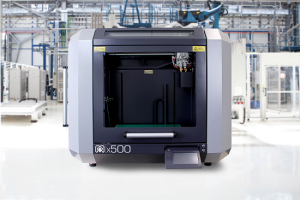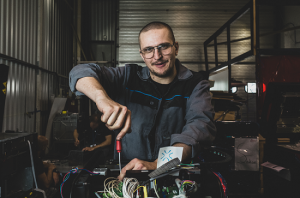For today’s 3D Printing News Briefs, we’re starting with some business and software news, then moving on to examples of things you can make with 3D printing – even the production lines for 3D printers themselves. EnvisionTEC has announced a strategic partnership with uLab Systems, BMW is saving time by using German RepRap’s x500, while AMFG has upgraded its AI workflow automation software. A Reddit user designed and 3D printed an iPhone dock for the car, and a Sinterit employee is using 3D printing to optimize the company’s 3D printer production lines.
EnvisionTEC and uLab Systems Simplifying Digital Orthodontics
 3D printer manufacturer EnvisionTEC and uLab Systems, which creates orthodontic aligner planning software, have announced a new strategic partnership, in which they will use an integrated solution to make aligner planning and production simpler for orthodontic professionals. uLab’s software imports patients’ 3D digital scans so that orthodontists can quickly make a plan chairside, and then a file is exported to make a 3D printed dental models for aligner trays and retainers. The company has validated EnvisionTEC’s Vida and Micro XL 3D printers, in addition to the best-selling Envision One cDLM, and worked with EnvisionTEC to simplify the integration, which includes a simple one-touch functionality.
3D printer manufacturer EnvisionTEC and uLab Systems, which creates orthodontic aligner planning software, have announced a new strategic partnership, in which they will use an integrated solution to make aligner planning and production simpler for orthodontic professionals. uLab’s software imports patients’ 3D digital scans so that orthodontists can quickly make a plan chairside, and then a file is exported to make a 3D printed dental models for aligner trays and retainers. The company has validated EnvisionTEC’s Vida and Micro XL 3D printers, in addition to the best-selling Envision One cDLM, and worked with EnvisionTEC to simplify the integration, which includes a simple one-touch functionality.
“We were attracted to the speed and ease of use of the Envision One. It will allow our customers the ability to easily transfer their cases directly to a powerful 3D printing solution capable of printing 6 horseshoe arches for clear aligners in 15 minutes,” said Charlie Wen, the Chief Technological Officer and President of uLab Systems. “Providing the highest quality patient care is now faster and more streamlined.”
To celebrate their partnership, EnvisionTEC and uLab Systems will be offering an exclusive hardware and software bundle. Such a partnership may make it easier for new entrants to join the aligner market. This market is dominated by Invisalign which 3D prints millions of aligners each year.
BMW Saving Time with German RepRap x500
One industry in which 3D printing has definitely made an impact is automotive, as manufacturers can implement ideas faster – saving time and money – by using the technology. 3D printing is often used to fabricate different car parts, fixtures, and prototypes, and due to the flexibility and speed inherent in the technology, companies that use it can work to achieve series maturity at a higher rate of speed, while avoiding bottlenecks. The BMW Group is one such company, having surpassed one million 3D printed components in November, and frequently gets its additive manufacturing systems from industrial 3D printer manufacturer German RepRap. For instance, it uses the German RepRap x500 3D printer to produce pre-development prototypes
“The field of application of additive manufacturing technology is diverse – from classic spare parts, for example, from old-timers that are no longer produced, to tools and auxiliary equipment, to parts that are used as end products. One of the most decisive advantages is the high degree of design freedom. It enables designers to develop completely new approaches in terms of design and function. Components with complex structures as well as bionic shapes, which are otherwise difficult or even impossible to manufacture, can be realized relatively simply, faster and in suitable quality with this technology,” German RepRap wrote. “German RepRap offers the corresponding material diversity. High-temperature materials, fiber-reinforced or flexible materials are used in different areas, depending on the requirements of the application. In addition, the car manufacturer benefits from a shorter production time as well as lower costs, because no tools have to be produced for the production any more.”
AMFG Upgrades AI Workflow Automation Software

AMFG’s Request and Ordering Portal provides a customizable and flexible solution for OEMs and service bureaus.
AI-powered, additive manufacturing workflow automation software provider AMFG has announced the release of a new upgrade to its platform in the form of a customizable Request and Ordering Portal. Part of the company’s modular, end-to-end workflow software platform, the new Request and Ordering Portal automates and standardizes the order request and handling process for service bureaus and OEMs. Thanks to its flexibility, the portal can be used to provide customers with an enhanced digital experience, as well as increase workflow efficiency.
“The ability to standardise the process of receiving incoming requests or orders for parts is the first step to establishing an agile and scalable additive manufacturing process. Our Request and Ordering Portal gives businesses the flexibility to eliminate the intrinsically manual nature of this process through automation,” said Felix Doerr, AMFG’s Head of R&D and Partnerships.
“The vast majority of companies are struggling to streamline the way in which they receive requests for parts internally, and this is compounded when AM operations are spread across multiple locations. Our portal helps to standardise the data that can be submitted to the AM or RP department from the outset, and automates the process so that machine operators no longer have to spend a huge proportion of their time on manually verifying each individual request.”
3D Printed iPhone Car Dock
 Utrecht-based engineer and designer Jeroen Mastenbroek posted his first functional print on Reddit recently: a dock for his iPhone 6S so it can sit in his car. Jeroen left a hole in the dock for a switch that is used to turn his Bluetooth audio on and off, and said that he designed the 3D printed smartphone dock specifically for use in his 2000 Peugeot 206 automobile.
Utrecht-based engineer and designer Jeroen Mastenbroek posted his first functional print on Reddit recently: a dock for his iPhone 6S so it can sit in his car. Jeroen left a hole in the dock for a switch that is used to turn his Bluetooth audio on and off, and said that he designed the 3D printed smartphone dock specifically for use in his 2000 Peugeot 206 automobile.
He posted the Thingiverse link to his functional print in the comments section, where several people offered some helpful tips, such as adding more top layers for increased rigidity so the infill doesn’t pillow quite as much. One user said that Jeroen could “reduce the gaps” by simply increasing the infill percentage, while another suggested that he install a switch which would automatically power up the Bluetooth each time the phone is docked. This is what I love about the maker community – for the most part, people can feel free to share their designs without fear of ridicule, and others happily offer up constructive criticism and suggestions so that a stranger can be empowered to make a better print.
Sinterit Employee Using 3D Printing to Optimize Production Lines
23-year-old Sinterit employee Szymon Grabowski is the son of a seamstress, and took his knowledge of tailor-made solutions with him to electric technical school, where he first encountered FDM 3D printing and used it to design and produce small electronics accessories. He wanted to continue in the field and soon joined the SLS 3D printer manufacturer, working on the production lines for its Lisa and Lisa Pro systems. But it wasn’t long before he realized that some of the company’s processes could be improved upon and accelerated, and got to work creating tools to optimize production as part of the company’s R&D department. His first redesigned device was a bed tester, which helps ensure proper layer heights for prints; Grabowski made a smaller, 3D printed version of this tester.
“It took me 12 hours to create a new device. During this time, I redesigned the electronics and drew a housing design. I printed the finished project on a 3D printer Lisa and assembled the whole thing,” Grabowski stated. “It took me just over one business day. As a result, I was able to create a device ready for work right away.”
Grabowski also redesigned a more advanced pyrometer tester, which monitors the temperature inside a 3D printer so ensure that it remains constant – very important when it comes to SLS technology. His tester is far more convenient, with additional functionality and reliability, and only took him 12 hours to design, 3D print, and assemble the pyrometer tester.
Discuss these stories and other 3D printing topics at 3DPrintBoard.com or share your thoughts in the Facebook comments below.
Subscribe to Our Email Newsletter
Stay up-to-date on all the latest news from the 3D printing industry and receive information and offers from third party vendors.
You May Also Like
Profiling a Construction 3D Printing Pioneer: US Army Corps of Engineers’ Megan Kreiger
The world of construction 3D printing is still so new that the true experts can probably be counted on two hands. Among them is Megan Kreiger, Portfolio Manager of Additive...
US Army Corps of Engineers Taps Lincoln Electric & Eaton for Largest 3D Printed US Civil Works Part
The Soo Locks sit on the US-Canadian border, enabling maritime travel between Lake Superior and Lake Huron, from which ships can reach the rest of the Great Lakes. Crafts carrying...
Construction 3D Printing CEO Reflects on Being Female in Construction
Natalie Wadley, CEO of ChangeMaker3D, could hear the words of her daughter sitting next to her resounding in her head. “Mum, MUM, you’ve won!” Wadley had just won the prestigious...
1Print to Commercialize 3D Printed Coastal Resilience Solutions
1Print, a company that specializes in deploying additive construction (AC) for infrastructure projects, has entered an agreement with the University of Miami (UM) to accelerate commercialization of the SEAHIVE shoreline...































